|
Nissan March / Micra
Debut: 2002
Maker: Nissan
Predecessor:
March / Micra (1992)
|
|
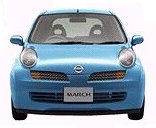 March
- or Micra to European - was the first Japanese car taking European Car
of the Year award. We praised its cute styling and quality engineering.
But that was 10 years ago. Why Nissan reluctant to replace it was a
mystery,
obviously not because of strong sales. In fact, March was struggling in
both home and Europe for a few years, even being outsold by its
derivative
Cube in Japan. March
- or Micra to European - was the first Japanese car taking European Car
of the Year award. We praised its cute styling and quality engineering.
But that was 10 years ago. Why Nissan reluctant to replace it was a
mystery,
obviously not because of strong sales. In fact, March was struggling in
both home and Europe for a few years, even being outsold by its
derivative
Cube in Japan.
A new
generation finally arrives. Styling-wise, it breaks the mold of regular
super-minis, bringing us a fresh idea. Still very cute, even a bit
girlie
(because target buyers are mainly young working women). The
high-mounted
elliptic headlamps distinguish it from all other mini cars on the
market,
so do the strong shoulder lines running towards the taillights, the
double-bubble
tailgate and all the fine details at nose and taillights. To me, it
looks
like a concept electric car.
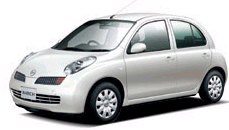 Mechanical-wise,
March is conventional. The platform - to be shared with next Renault
Clio
and Twingo - employs MacPherson struts and torsion beam suspensions.
Pure
electric power steering is just as predictable. The car’s overall size
is compact by class standard. Measuring 3695mm in length, it is a
massive
135mm and 200mm shorter than Honda Fit and VW Polo respectively,
although
width and wheelbase matches the class standard while the 1525mm height
is among the tallest in class. Mechanical-wise,
March is conventional. The platform - to be shared with next Renault
Clio
and Twingo - employs MacPherson struts and torsion beam suspensions.
Pure
electric power steering is just as predictable. The car’s overall size
is compact by class standard. Measuring 3695mm in length, it is a
massive
135mm and 200mm shorter than Honda Fit and VW Polo respectively,
although
width and wheelbase matches the class standard while the 1525mm height
is among the tallest in class.
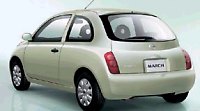 Nevertheless,
the interior is spacious and feels airy. Rear passengers get 100mm more
legroom than before. Unlike Honda Fit, March does not try to be a mini
MPV - that mission will be fulfilled by the next generation Cube -
therefore
seating and storage arrangement is conventional. Dashboard design is
simple
and, again, feminine, but fails to match the imaginative exterior
design.
Like many recent Nissans, it employs poor quality plastics all over the
cabin. In contrast, equipment level is very good, with satellite
navigation,
telematics and keyless entry / engine start. Nevertheless,
the interior is spacious and feels airy. Rear passengers get 100mm more
legroom than before. Unlike Honda Fit, March does not try to be a mini
MPV - that mission will be fulfilled by the next generation Cube -
therefore
seating and storage arrangement is conventional. Dashboard design is
simple
and, again, feminine, but fails to match the imaginative exterior
design.
Like many recent Nissans, it employs poor quality plastics all over the
cabin. In contrast, equipment level is very good, with satellite
navigation,
telematics and keyless entry / engine start.
 March
offers 3 petrol engines, all come from the new CR-series four-cylinder
with twin-cam 16 valves. They displace 1.0, 1.2 and 1.4 litre, produce
68, 90 and 98hp respectively, more powerful than rivals. In addition to
the relatively low kerb weight, all engines provide brisk performance
even
though they are coupled to a 4-speed automatic. 5-speed manual and CVT
will come soon. In 2005, Nissan replaced the 1.4 engine with the new
1.5-litre engine from Tiida (109 hp JIS), together with CVT
transmission. At the same time, European version Micra got an even
larger 1.6 litre engine (110hp DIN) with manual gearbox to power the
hot version Micra 160SR. March
offers 3 petrol engines, all come from the new CR-series four-cylinder
with twin-cam 16 valves. They displace 1.0, 1.2 and 1.4 litre, produce
68, 90 and 98hp respectively, more powerful than rivals. In addition to
the relatively low kerb weight, all engines provide brisk performance
even
though they are coupled to a 4-speed automatic. 5-speed manual and CVT
will come soon. In 2005, Nissan replaced the 1.4 engine with the new
1.5-litre engine from Tiida (109 hp JIS), together with CVT
transmission. At the same time, European version Micra got an even
larger 1.6 litre engine (110hp DIN) with manual gearbox to power the
hot version Micra 160SR.
As
we have already said, March is designed to please female customers.
Therefore
its suspension is tuned to provide comfortable ride rather than
entertaining
handling. Attack corners at high g-force will find it rolls
considerably.
But it is easy to drive, with accurate steering and good brakes.
|
| The
above report was written
on 18 Mar 2002 and last updated on 10 Oct
2005. All Rights Reserved. |
Micra C+C
|
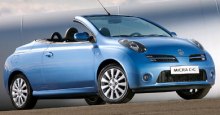 The
C+C (coupe plus cabriolet) version of Micra was designed and engineered
Britain instead of Japan. It is also being produced exclusively in the
UK plant at Sunderland. The roof is made by German cabriolet specialist
Karmann (like Renault Megane CC), which set up a small production
facility in the Sunderland plant to build and install the roof
mechanism. The
C+C (coupe plus cabriolet) version of Micra was designed and engineered
Britain instead of Japan. It is also being produced exclusively in the
UK plant at Sunderland. The roof is made by German cabriolet specialist
Karmann (like Renault Megane CC), which set up a small production
facility in the Sunderland plant to build and install the roof
mechanism.
Despite of its small size and cheap price (at £14,000 only),
Micra C+C has one of the best roof mechanisms in the world. It is tight
fit, well sealed and occupies little space - 457 litres of luggage
space is left once the roof is up, or 225 litres when it is down. This
is larger than many cars a class above. Moreover, the roof is
made of glass to enhance airy feel of the cabin. The whole mechanism
takes 22 seconds to open and close.
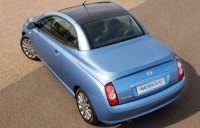 Like
most other CC, the windscreen is made lower and steeply raked in order
to make the roof panel small enough to be stored in the boot. The lower
roof results in a 110mm reduction on overall height. Inevitably, tall
drivers will find headroom tight while the windscreen pillar is too
close to their heads. The boot is lengthened by 90 mm, so the CC looks
more like a coupe than a straightforward conversion of the Micra
hatchback. The 2+2 seating (proper rear seats are sacrificed for the
roof) also promote this coupe feeling. Like
most other CC, the windscreen is made lower and steeply raked in order
to make the roof panel small enough to be stored in the boot. The lower
roof results in a 110mm reduction on overall height. Inevitably, tall
drivers will find headroom tight while the windscreen pillar is too
close to their heads. The boot is lengthened by 90 mm, so the CC looks
more like a coupe than a straightforward conversion of the Micra
hatchback. The 2+2 seating (proper rear seats are sacrificed for the
roof) also promote this coupe feeling.
The Micra C+C has two engines to choose from: a 88hp 1.4 and 110hp 1.6.
The 1.6 engine is lively and provides decent performance. The chassis
feels very matured, being noticeably stiffer than direct rival Peugeot
206 CC (admittedly, the trend-setting Peugeot is almost 5 years old
now). This give the Micra C+C fine handling and ride compliance.
Overall, this car is well built, fun to drive and a bargain.
|
| The
above report was last updated on 10 Oct
2005. All Rights Reserved. |
|
|